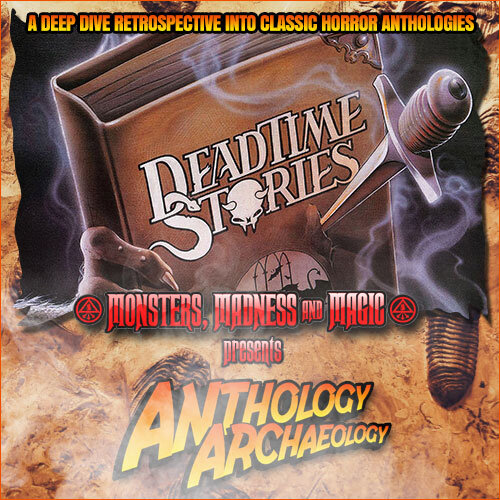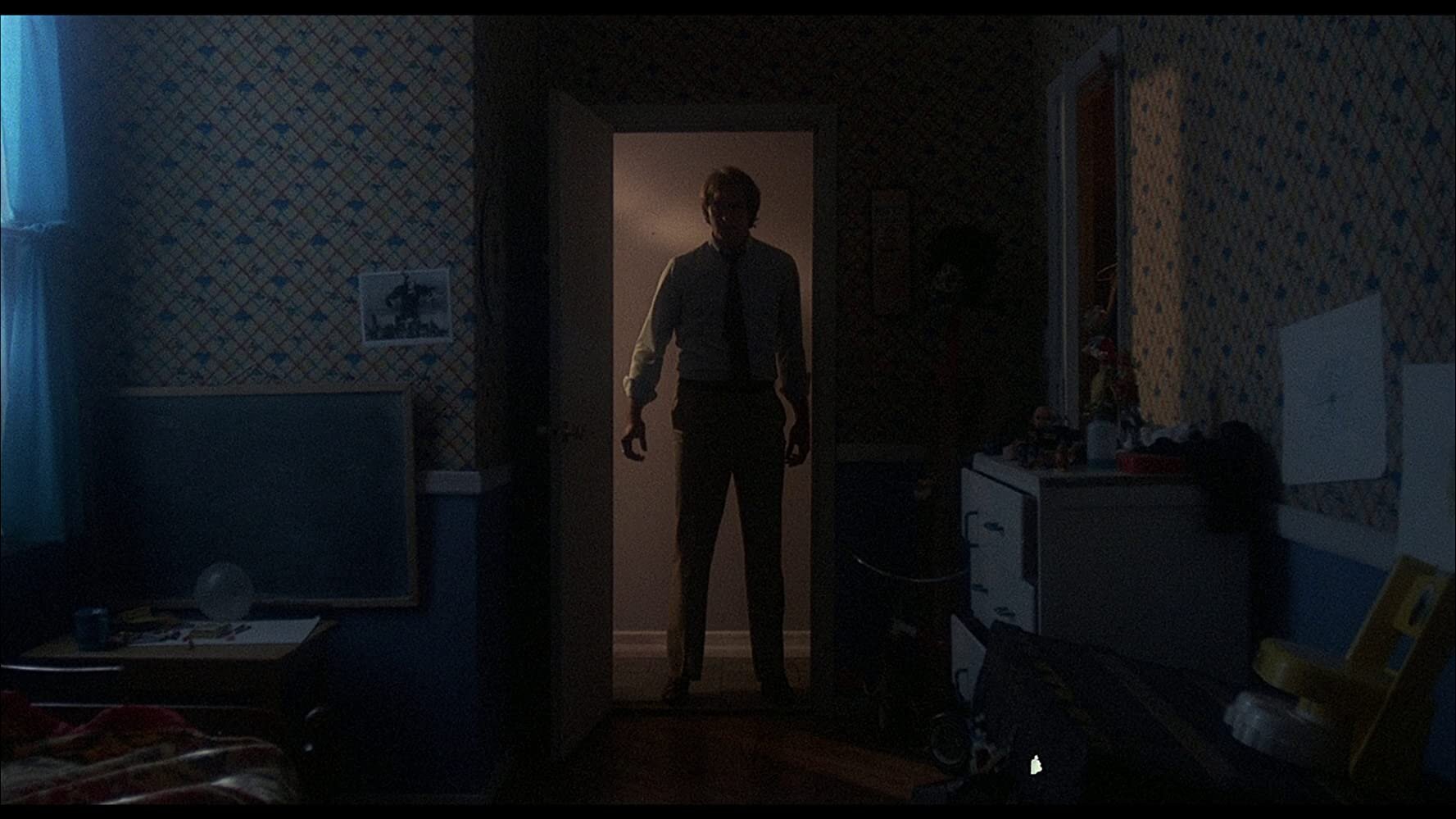Anthology Archaeology: Deadtime Stories
Anthology Archeology is a new series here at M3 where I, your humble horror host, will guide you, the reader, through a smorgasbord of my personal favorite schlock. Not just any common cheese, mind you. I prefer a specific species - the short and sinister variety. The sort that slithered and seeped their way on to the bottom rack of the local video store and traversed their way into tape players by way of badass box-art and some eerie elbow grease. All the lovable little ghouls, ghosts, witches, werewolves, monsters, and madmen, all perhaps presented in the same package. Tidbits of terror fit for consumption in a single sitting. Sign me up, every time.
Anthologies certainly get a lot of hate, and I’m not here to argue. The stances taken and points provided by those opposed to the format are legitimate. You may not have enough time to fully explore and evolve the characters, flesh out the setting, establish subplots, and all of those crucial elements, but I don’t care. I’ll be in the dumpster, devouring those damn things all day long. Maybe it’s that these movies don’t overstay their welcome when it comes to my lack of an attention span or force me to take notes to keep up with all the subtext, but I love them. Perhaps after our adventure, you will as well.
Without further ado, let’s get started. Our first collective dig into the dark, dear reader, shall display nearly all of the creatures and features listed above. Witches, werewolves, goblins, and bears (kind of), oh my! Oh yes, how could I forget?
And a little something extra.
That’s right. 1986’s Deadtime Stories (also known as Freaky Fairy-Tales) delivers the holy grail of horror. The original song. Director Jeffrey Delman is responsible for the theme, lyrics, and this gem of a movie itself. Kudos and a round of applause to you, Mr. Delman. Heeding the advice of Merycful Fate, you did not break the oath, sir! Once you have taken the box-art bait and bring this baby back home, that title sequence is going to hit, and you’re going to know that your faith in the Olde Ways is going to be rewarded tenfold. All doubt has been lifted. “This is going to be awesome,” you said to yourself. And you were right.
Deadtime Stories takes a tongue-protruding-from-an-open-wound-in-cheek approach to classic fairy tale tropes. Our fascination with fear festers at a young age. Embedded in the stories we are told as children are all the elements contained within modern horror. For example, the German tale chronicling the plight of Hanzel and Gretyl as they are abandoned in the deep, dark forest, lost, only to stumble upon a witch of the woods. Or the story of Red Riding Hood, with variations from England, Italy, and Greece. The dangers of the forest and, more prominently, of the unknown penetrate our minds regardless of time and distance. Composed of terrifying themes, the history of the night was passed down through the ages, stories told to children by the campfire, that once traveled only by word of mouth, began to appear in writing, leading to the alchemical amalgamated of historical folklore with horror fiction with Horace Walpole’s The Castle of Otranto in the 18th century.
Monsters have been present in our minds since before we could voice and give life to the figures creeping through our imaginations. The shadows that stalk, the darkness that moves out of the corner of your eye. No one knows how to tell a better scary story than you. You were born with the fear and it has stayed with you, with us, since. There’s no escaping what comes with the innate programming, my friends. Best just to watch some horror anthologies and get in touch with your ancestors. There are very few things that exist in this world more potent and primal than a scary story.
Whoa, I know what you’re thinking. Really, Walpole and Deadtime Stories in the same paragraph? I’m just simply highlighting that there is a very thin, if any line, between fairy tale and horror story. As the song says, folks, ‘it’s no wonder why we turned out like we did, rememberin’ our bedtime tales as kids’. Taking an overly comedic and cheese-filled approach, Deadtime Stories is a fitting plunge into the anthology subgenre, especially for a kid. If you’re cool with that kid seeing the inevitable eighties horror nudity, that is. The movie opens with our master of the macabre and orator of the odd and strange for the evening, Uncle Mike, sneaking up on his unsuspecting nephew, Brian, who is up after his bedtime because there’s a monster in his room, allegedely.
Uncle Mike
Uncle Mike begrudgingly agrees to appease his nephews crave for the grave, and spins his first yarn in an attempt to send little Brian off to la-la land. What better way to lure a young lad to slumber than to recount the tale of Young Peter, a fisherman’s son, kidnapped by two witches, forced to do their bidding? I can’t think of one. Nice selection, Uncle Mike. Do you know what would make this story even cooler? If Peter was played by Scott Valentine of Family Ties fame. Spoilers ahead: He is. Practitioners of Witchcraft have long appeared as harbingers of doom and evil in mythology, and have served as unfortunate victims of persecution and branded the eternal scapegoats of society in reality. It’s only fitting that the first segment of our inaugural installment highlights the hag.
““Yet tell me,” said the summoner, “if true:
Do you make your new bodies always so
Out of the elements?” The fiend said, “No,
Sometimes it’s only some form of disguise;
Dead bodies we may enter that arise
To speak with all the reason and as well
As to the Endor witch spoke Samuel.””
Chaucer’s’ reference to the biblical Witch of Endor, who spoke with the spirit of the dead prophet Samuel at the request of King Saul is but one of many appearances of the witch in classical literature and mythology. Circe, the Witch of Aeaea, daughter of Hecate, Goddess of Witchcraft, who turned the soldiers of Odysseus to swine. The Baba Yaga, of Slavic origin, Morgan La Fey, of Celtic roots. The idea of the witch is present in every period of human history. The image of the crone conjures the frailty of mortality, the inevitability of old age, of eventual death. If Brian is going to learn his spooks and learn them well, Uncle Mike couldn’t have chosen a better starting point.
After the first tale concludes, Brian is still fighting off the sirens of sleep. Uncle Mike is going to have to bring out the big guns. The second story is propelled by my personal favorite creature of the night: the werewolf. Detailed much more deeply in Western Werewolfery, the fear of Wolf-man is one that I relate to on a molecular level. I’m not alone, either. Like the witch, the werewolf appears in the human psyche in some form across the globe. The shapeshifter, the dogman, Black Shuk, the black hound of Britain. There was a time when humans did not rest atop the food chain. The primal fear that the werewolf taps into is ancient and ever-lasting. It’s in our genetics to get the hell out of town in the presence of impending death.
There are numerous historical accounts of Lycanthropy, diabolic deeds done under the full moon, and attributed to hex, curse, or disease. One of the more famous and documented cases of Lycanthropy is the tale of Peter Stumpp, now known to history as the Beast of Bedburg, who allegedly began to dabble in the occult arts as early as the age of twelve. Stump was accused and found guilty of the murder and mutilation of many young men, women, children, and cattle. Stumpp himself was tortured, beheaded, and burnt to ash. If you ask me, Uncle Mike is on a god damn roll!
Seriously, who would be able to sleep as a kid after hearing a werewolf story? Certainly not me and certainly not little Brian. Mike realizes that he has to end on a tame note and concludes with a modern retelling of Goldilocks and the Three Bears. The nursery tale itself has several different endings and variations, many of which are unfortunate for Goldilocks. Including but not limited to being lost in the forest (sound familiar?) or being eaten by beasts (Ah-ha!). In the original story, the protagonist was an old woman, eventually replaced by the girl we all know today.
So what’s the moral of the story, kids? Well, screw me for spoiling a 35-year-old movie, but the monster in little Brian’s room is real and, well, you’ll see. It may not be a werewolf, a wicked old witch, or three talking bears, but the monsters are out there. Whether he knows it or not, Uncle Mike is more than preparing Brian and anyone else that watched Deadtime Stories for the horrors that have haunted our subconscious since the dawn of humankind.
Whew! Now that was a dirty dig. I’ve you’re still reading this, I’ve hope you’ve enjoyed our first adventure together in Anthology Archaeology. I’ll see you on the next expedition.





